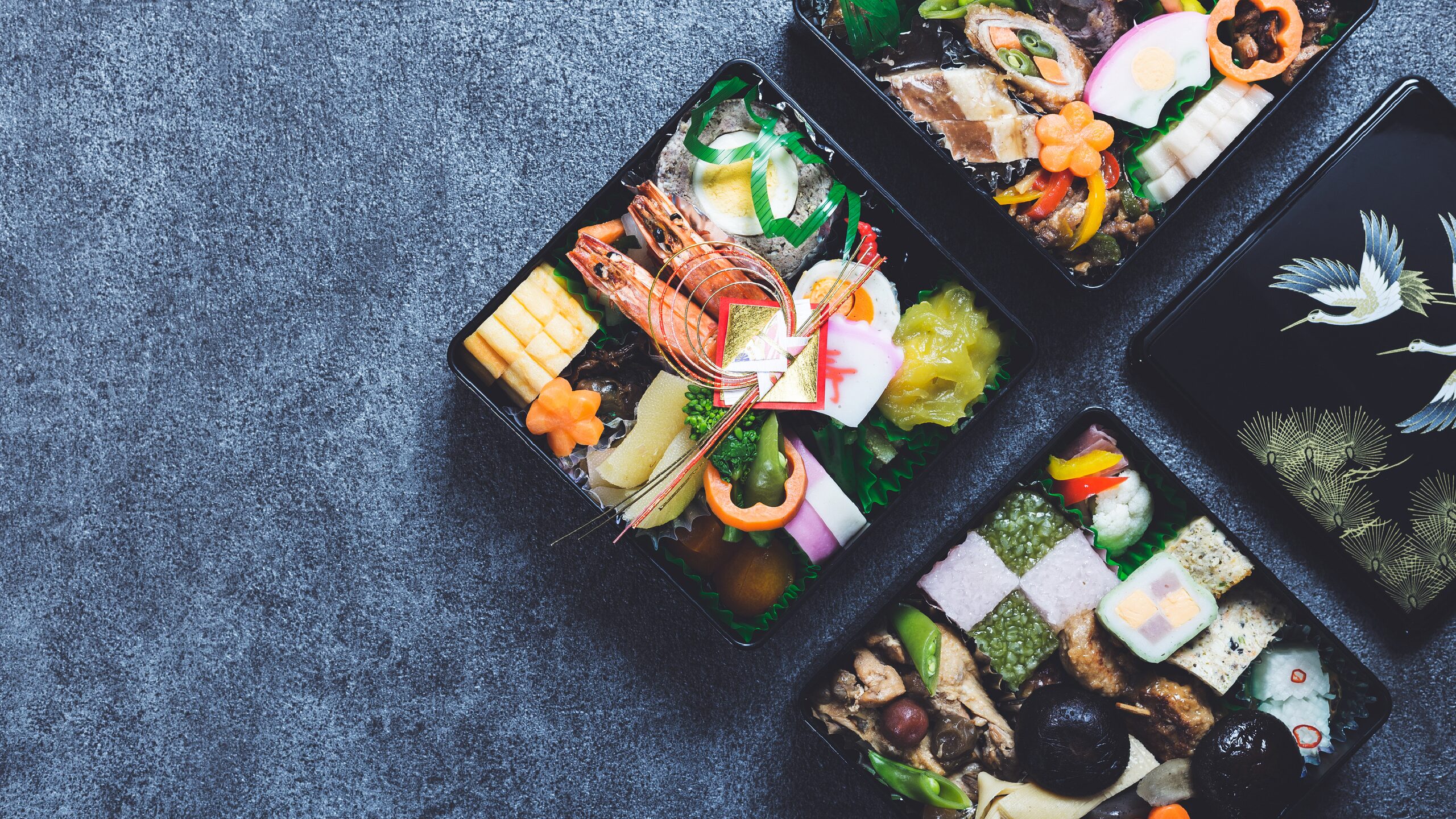In Japan, specific meals are traditionally eaten during the New Year. Each dish and ingredient is imbued with meanings of wishing for good luck and health. For example, buckwheat noodles are eaten on New Year’s Eve, and Osechi-ryori is eaten at the beginning of the New Year. Today, we will introduce why these meals are eaten, their underlying meanings, and history. We will also showcase what supermarkets look like during this time.
1. Osechi-ryori:
Osechi-ryori is a special meal prepared to celebrate the New Year, consisting of various types of small dishes beautifully arranged in a tiered box. Each dish represents wishes for longevity, happiness, and prosperity. Typical dishes include black beans (health), kamaboko (celebration), datemaki (symbol of wisdom), kazunoko (prosperity of offspring), tataki gobo (family unity), kuri kinton (sweetened chestnuts), tazukuri (sweet and spicy small fish), and kombu rolls (fish wrapped in seaweed considered auspicious).
2. Toshikoshi Soba:
There are various theories about the origin of Toshikoshi Soba, but it is believed to have started during the Edo period. In the merchant houses of the Edo period, it was customary to eat soba on the busy final day of the month (New Year’s Eve) as a quick meal, which later became known as “Toshikoshi Soba.” Additionally, soba is long and thin, symbolizing wishes for longevity and health, and it is easier to cut than udon, symbolizing cutting off the misfortunes of the past year and welcoming the New Year.
3. Ozoni (Zoni):
Ozoni is a soup dish with mochi (rice cake) and varies regionally. Mochi symbolizes longevity and prosperity. The soup base (dashi) is made with soy sauce, miso, or salt, and typically includes vegetables and seafood.


At the end of the year, supermarkets in Japan extensively sell Osechi-ryori, the traditional New Year’s cuisine. Also available are cakes and other confections incorporating traditional ingredients like kuri kinton, a sweet chestnut paste. During this period, a wide variety of ‘soba’ (buckwheat noodles) are offered, including both frozen and chilled options, reflecting the custom of eating soba on New Year’s Eve.
We pick Kuri kinton today as it has potential for product development all over the world. It is used the popular ingredients Sweet potato and Maron. Kuri Kinton is a traditional Japanese dish often prepared for the New Year as part of Osechi-ryori, the special New Year’s cuisine. It is a sweet paste made from chestnuts and sweet potatoes.
The main ingredients of Kuri Kinton are chestnuts (marrons) and sweet potatoes (satsumaimo), both of which are cooked in sugar. These ingredients are mashed together to form a paste, resulting in a beautiful golden color. This golden hue symbolizes wealth and prosperity, and eating Kuri Kinton during the New Year is believed to bring good fortune for the year ahead.
Kuri Kinton is popular for its unique sweetness and creamy texture, making it a favored item in the array of Osechi dishes. The natural sweetness of the chestnuts combined with the softness of the sweet potatoes creates a delightful harmony of flavors.
Source: https://www.maff.go.jp/j/agri_school/a_menu/oseti/01.html



Related Articles
TOFU sweet bar innovation
Martner Japan insight comment The Tofu Bar is a clean-label, plant-based food product that maximizes the natural power of soybeans by eliminating unwanted bitterness and off-flavors. Seasoned and ready-to-eat, it is designed to suit a variety of modern...
Sweet potato snacking “Salted Karinto made with ‘Kogane Sengan’, a premium sweet potato grown in Kyushu Japan
Martner Japan insight comment "Imo Kenpi" is a traditional Japanese snack made by deep-frying thin strips of sweet potato and coating them with a light sugar glaze. It pairs perfectly with Japanese tea or other beverages, yet this simple and delicious snack remains...
FIZZPRESSO: Redefining RTD Coffee with Sparkling Espresso Innovation
Martner Japan insight commentSuccess for FIZZPRESSO will depend on how effectively ITO EN can frame it not as “coffee with bubbles,” but as a new category altogether—akin to the way hard seltzer or cold brew evolved beyond their origins. Positioning, packaging, and...




